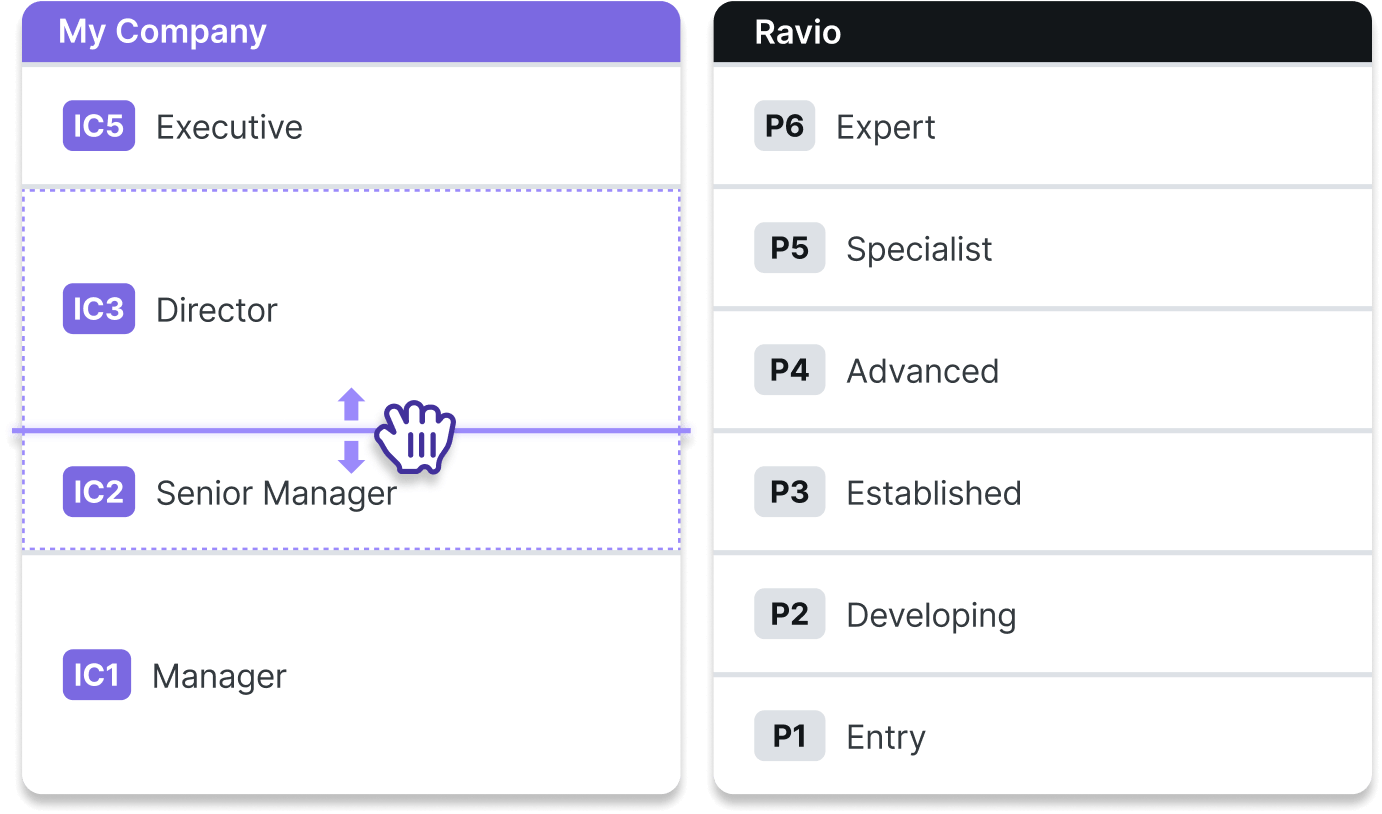VP vs Director: Tackling job title inflation in senior leadership roles

Job title inflation has skyrocketed in recent years, with titles including words like “Leads” having tripled between 2019-2023.
Nowadays, more and more companies are looking for ways to attract and retain top talent in a competitive market – and, in some cases, buy time before needing to offer salary increases.
Offering senior titles like VP or Head of or Director, especially with a smaller team without a structured job architecture in place, can seem like a simple and easy win.
However, this causes a whole host of issues further down the line. Offering senior job titles to employees without the skills and responsibilities can cause confusion with organisation structure, salary benchmarking, salary bands, and career progression.
We talk to Matt McFarlane, Director at FNDN about how to deal with the challenges presented by job title inflation, especially across senior leadership roles in tech such as VP, Director, or Head of.

3 ways to tackle job title inflation in leadership roles
From salary benchmarking challenges to top-heavy organisational structures, title inflation is a risky strategy that can undermine long-term growth. Below are three major issues that arise from inflating senior leadership roles within your organisation.
1. Ensure job titles are not a substitute for salary increases
One of the biggest reasons for job title inflation is competition for talent. As startups compete for skilled professionals, offering senior job titles becomes an attractive strategy. Instead of increasing salaries to match market rates, companies hand out leadership titles like ‘Director of Engineering’ or ‘Head of Engineering’ to get candidates through the door.
"Because startups are often cash-strapped, titles can be used as a substitute for a more competitive salary," says Matt McFarlane, Director at FNDN. "You might have someone levelled as a senior manager based on experience but offered a Director role by a new employer just to secure the hire."
While this might seem like a clever workaround, it can backfire.
Employees often don’t end up doing the role the title suggests, and that misalignment can lead to internal confusion and tension.
For example, a VP title without corresponding strategic oversight can not only disrupt team dynamics, but ultimately hinder performance as the company scales.
Subscribe to our newsletter for monthly insights from our compensation dataset and network of experts, to help you navigate a career in Rewards 📩
2. Avoid top-heavy management structure
Without a clear job architecture, companies can end up with a messy hierarchy where leadership titles don’t align with actual duties. Leadership roles like VP, Director, or Head of are meant to signal a specific level of strategic responsibility and decision-making – but when companies assign these titles without defining responsibilities, it leads to confusion.
According to Matt, this problem usually stems from founders or early-stage leaders who haven’t built a structured job architecture but who have grand visions for where the company is going.
"In the absence of structure, founders think of roles that someone can grow into rather than what they should be doing right now," says Matt.
This results in a top-heavy management structure, where senior-sounding roles don’t equate to senior responsibilities. As companies scale, this lack of clarity becomes more problematic, leading to conflicts, overlapping roles, and a lack of accountability.
In the long run, companies are forced to either hire above inflated roles by introducing micro-layers, or reset the levels – which can result in difficult conversations.
“Firstly, you can keep them at that level, despite the set of expectations and responsibilities not being met by the current individual. Correcting the level is often the more challenging option – giving them the lower level and talking about growth paths can be difficult but necessary.”

3. Ensure job titles align with market benchmarks
Another significant issue with title inflation is its impact on market alignment when compensation benchmarking. When a role is given a senior-sounding title without corresponding responsibilities, it becomes challenging to determine accurate market compensation.
"I think another challenge when it comes to job title inflation is when organisations inevitably start to market price. They want to understand what this role can fetch in the market," says Matt McFarlane.
The issue arises when companies benchmark roles based solely on title rather than the actual skills or responsibilities associated with the role.
This often leads to either overpaying or underpaying employees, because companies match something on title only when the corresponding responsibilities could be greater or less than those being priced by the market – creating pay inequity and tension within the organisation.
For example, a Director-level title will command a higher salary in the market, but if the role is actually performing more like a Manager, the company risks significantly overpaying without gaining the expected leadership output.
"You really risk overpaying for somebody who actually isn’t performing the role," Matt explains. "So you start to outlay cash that isn’t giving you the delivery that you’re expecting."
"It’s important to strike that happy medium between giving them that little bit of ego boost while ensuring consistency and structure of the job levels as well," says Matt.

When to build structure at leadership level as you scale
While title inflation might start as a short-term fix, this blog has covered how it usually signals a deeper issue: the absence of a structured, scalable job architecture.
If your company doesn’t clearly distinguish between what a Manager, Director, or VP is responsible for, titles will quickly lose meaning – leading to pay equity issues, confused and frustrated employees and overall brand damage.

But for small startups that don’t have a problem yet, you might be asking: when is the right time to add this structure?
Generally, the sooner the better. But for Matt, there’s a clear tipping point as companies start to scale – often around 100 to 200 employees – where it's no longer sustainable to have “scrappy operators” holding vague, inflated titles.
“At the start, there's a lot of ‘Heads of’, and those heads have a very generic broad meaning,” Matt says. “Then as you start to add levels of seniority – especially in more mature startups – the ‘Head of’ tends to fall away, and you introduce a VP, Director, Manager-type structure.”
He explains that this shift usually coincides with the moment a startup begins to hire more experienced leaders who bring a strategic lens to the business. This can be at any stage, but it’s usually from Series A/B toward Series C and beyond.
Another important signal that it’s time to build structure is when promotions start happening based on tenure rather than capability.
“If I'm in a 200-person startup and now we're 600, I naturally just assume that I should have been promoted to a certain level,” says Matt. “But you really need to lean into what defines a role – the skills, the competencies, and expectations – and not be pressured to give people that sort of tenure-based promotion.”
Matt also notes that if you’re finding it difficult to apply your job level framework in practice, that’s often a sign something’s not quite working. It might feel like roles don’t neatly fit into the levels you’ve defined, or managers are unsure where to place someone because their responsibilities seem to span across multiple levels. When that starts happening, it’s usually an indicator that your structure isn’t quite the right size or shape for your company at that point in time.
“It became really difficult to essentially grade a role into a level… the roles kind of straddled two or three levels,” he says. “For me that was an immediate flag that we’re trying to make something fit that just is not the right size for us.”
And as the team grows, it’s also worth rethinking how leadership tracks and IC/Professional tracks evolve.
“All startups start at a point where I wouldn’t say they have a concrete individual contributor and manager stream… So keeping an eye on when you’re ready for that transition – to actually bifurcate the career tracks – is really critical as well.”
“You need to lean into what defines a role – skills, competencies, expectations – and not be pressured to give people tenure-based promotions because they’ve been at the company since the start.”

Director of FNDN
How to define senior leadership roles: VP vs Director vs Manager
Implementing a well-designed senior leadership structure, including each job level within the management team and the job title conventions for each of these levels, is crucial for avoiding job title inflation.
But different organisations interpret titles like VP, Director, and Manager differently, depending on their size, structure, and maturity. This can make it difficult to create a consistent approach.
Matt shared his advice with us on how to think about building the right senior leadership structure for a company’s specific needs.
1. Establish clear criteria for different leadership roles
To build a scalable leadership structure, it’s crucial to establish clear criteria for each role. Rather than fixating on the title itself, focus on the responsibilities, scope, and strategic impact of the role.
Matt McFarlane emphasises that the first step to defining leadership roles is to decide on the key factors that will differentiate one leadership level from another. According to Matt, this helps avoid the common mistake of assigning inflated titles without clearly outlining the responsibilities that come with them.
"Assessing how big their team is and the seniority of their direct reports can be a great indicator for how to define leadership roles. A VP will often have Directors as direct reports, and Directors will often have Managers as direct reports, and so on. You can start to create a little bit of a pattern around that," says Matt.
Matt also highlights three core areas that should be clearly defined when building a job level structure:
- Span of control: Understand the number of direct reports and their seniority. For example, a VP might oversee multiple Directors, while a Director might oversee several Managers. This creates a natural hierarchy that scales with the business.
- Decision-making authority: Clearly define how much budgetary oversight and strategic decision-making power each role has. For instance, VPs might have authority over multi-million dollar budgets, while Directors manage departmental budgets.
- Strategic vs operational focus: Differentiate between roles that are primarily strategic, like VPs, and those that are operational, like Managers. VPs often steer the overall direction of a function, while Managers focus on day-to-day project execution.
"A lot of the time, companies are just guessing when it comes to defining leadership roles. The key is to set clear expectations for how much decision-making power, budget oversight, and cross-functional influence each role has.”

Director of FNDN
2. Create specific, clear titles
Generic titles like "Head of" can be problematic because they lack consistency and make benchmarking difficult.
"I've seen 'Head of' used for people running a team of three as well as those leading entire departments. It lacks consistency and makes it hard to benchmark salaries and expectations," says Matt.
Instead, clearly define each leadership role based on responsibility and job scope. For example, "Director of Engineering" should indicate overseeing multiple engineering teams, while "Engineering Manager" should specify managing a single team. This level of precision helps prevent title inflation and confusion.
💡Defining the most common leadership job titles in tech
Here's how Matt thinks about the key differences between VP vs Director vs Manager vs Head of in senior leadership roles.
VP (Vice President)
- Typically oversees entire departments or multiple teams.
- Responsible for strategic planning and aligning departmental goals with company vision.
- Often has Directors reporting into them.
- Example: VP of Engineering overseeing several multiple engineering teams and setting technical strategy for the whole organisation.
Director
- Focuses on managing specific teams or functions within a department.
- Operates at a more tactical level compared to VPs but still holds strategic responsibility.
- Reports to a VP or C-level executive.
- Example: Director of Product managing multiple product managers and leading product strategy.
Manager or Senior Manager
- Directly oversees small teams or individual contributors.
- Responsible for day-to-day operations and delivering on specific projects or tasks.
- Reports to a Director or VP.
- Example: Engineering Manager leading a software development team and ensuring project completion.
Head of
- Often used as a catch-all title, which can lead to ambiguity.
- Typically used in startups where formal hierarchical structures are not yet established.
- Role should be clearly defined to avoid confusion.
- Example: Head of Marketing responsible for brand strategy and campaign execution.
3. Use a job levelling framework
To make defining leadership roles easier, many organisations use a levelling framework. Levelling frameworks map out roles across career tracks and levels, helping to define progression and ensure consistency in both internal structures and external benchmarking.
For example, Ravio’s job levelling framework categorises roles into distinct career tracks:
- Executive: leadership roles which oversee core functions. These include VP, SVP, and C-level
- Manager: oversees a team, with success measured based on the team’s output and impact on the business. These include: Senior Director, Director, Senior Manager, Manager, Supervisor
- Professional / Individual contributor: success is measured based on individual output and impact on the business. Includes titles from Entry to Expert.

Ravio's job level framework
4. Keep it simple and flexible
Startups often make the mistake of over-engineering job levels, which can lead to confusion and be challenging when HR leaders want to add to it.
“One mistake I’ve seen is creating too many leadership levels too soon. Startups might jump from 50 to 150 employees and suddenly add VPs, Directors, and multiple Head of roles without thinking about how they fit together.” – Matt McFarlane
To avoid this, Matt says it’s crucial that companies build with flexibility and scalability in mind – avoiding locking roles into overly prescriptive descriptions that stifle adaptability, especially in high-growth environments.
“You always want to be a step ahead of where you are now when it comes to job architecture – especially if you’re a growing start up. If you have something too much bigger, you start to lead into a real disconnect between your people and your job level structure.”
It’s also essential to proactively determine when to add new leadership layers. Instead of reacting to individual promotion requests, evaluate the strategic need for an additional layer by asking key questions:
- Is the span of control too broad? If leaders manage too many direct reports, it may be time to introduce another layer for more effective oversight?
- Is there a strategic need? Sometimes adding a new layer isn’t about workload but improving strategic oversight.
- Are roles clearly defined? Make sure each role’s responsibilities are clear and distinct, preventing overlaps or ambiguity.
"A good yardstick is to consider the scale of responsibility and whether the current structure is creating bottlenecks. If one leader is overseeing too many functions, it’s time to introduce a more specialised leadership role."

Director of FNDN
5. Define clear career progression pathways
Defining senior leadership titles also means defining the clear progression pathways for these individuals. When you pay for performance or based on the market, promotions shouldn’t happen by default or be based on tenure – but instead because of demonstrated skills, competencies, and measurable impact.
"When companies double in size, there’s often pressure to promote people who’ve just ‘been around the longest’. That’s a mistake. It needs to be skills-based, not just tenure-based, otherwise you end up with leadership gaps and poorly managed teams," says Matt McFarlane.
To make career progression consistent and transparent, outline the specific skills and achievements required to move from one level to the next – whether that’s from Manager to Director or Director to VP.
Matt also warns against creating overly complex career frameworks, especially in startups where flexibility is essential. Engineering teams, for example, can sometimes over-engineer career paths, adding unnecessary layers and making progression rigid.
"You don’t want to overcook your career frameworks, especially when you’re still growing. Keep them simple and adaptable so people can step into new roles as the business evolves," says Matt.
📊 Did you know that Ravio automatically levels your employees when you onboard?
Building a robust level framework that defines leadership roles in your company, getting stakeholder alignment, and levelling all roles can be a painful process. To make it simple, when you register with Ravio, we automatically level your employees against our level framework.
If you’d like to learn more and get a full tour of the Ravio platform book a demo with one of our experts – or take a look yourself with 3 free benchmarks.
If you're looking for support with implementing the right compensation approach for your startup, we'd also highly recommend exploring Matt's services at FNDN.